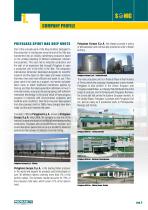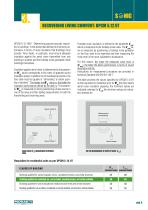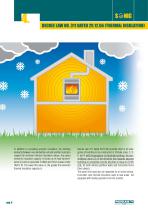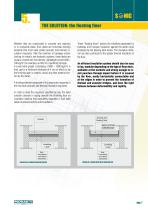Catalog excerpts

SONIC PANEL and SONIC ROLL Floor deck sound absorption and waterproofing system IN COMPLIANCE WITH D.P.C.M. 5-12-1997 ONACOUSTIC INSULATION REQUISITED AND D E C R E E LAW No. 311 D AT E D 2 9 - 1 2 - 2 0 0 6 ON T H E R M A L I N S U L AT I O N
Open the catalog to page 1
Company profile Noise is annoying Recovering living comfort: il DPCM 5.12.97 Decree Law 311 del 29.12.06 (termal insulation) The solution: the floating floor The Sonic solution: - system components - examples of laying - advantages How to design an insulation system: The forecast calculation of L’n,w How to design an insulation system: Calculating thermal insulation Laying the SONIC System: - checking the sub-foundation - laying Sonic Panels - laying Sonic Roll - finshing the skirting - radiating floors On-site testing and certification page page page page page page 8 page 9 page 10 page 11...
Open the catalog to page 2
COMPANY PROFILE POLYGL ASS SPIRIT HAS DEEP ROOTS Part of the concrete work of the three brothers dedicated to the production of roofing ever since the end of the ‘60s was transformed into an initially rudimentary production based on the unlikely blending of different substances, bitumen and polymers. This soon led to industrial production and the start of an expansion that brought Polyglass to open a productive unit in the USA in the ‘80s. The company’s international dimension developed alongside its scientific research and the desire to offer newer and newer solutions that were more and...
Open the catalog to page 3
Noise is a signal of disturbance for the information transmitted in a system. Like sound, noise is composed of sound pressure waves and produced by countless natural and artificial sources. An excess of high-intensity sound is defined as acoustic pollution with consequent damage to the natural and urban environment. Acoustic pollution can also be produced inside the building itself and whenever the noise of the systems or people is transmitted from one home or office to another, in this way reducing both comfort and privacy. Acoustic pollution is opposed in the home or any closed area...
Open the catalog to page 4
RECOVERING LIVING COMFORT: DPCM 5.12.97 DPCM 5-12-1997, “Determining passive acoustic requisites in buildings” is the decree that defines the minimum performance in terms of noise insulation that buildings must provide. Floor decks, in particular, must ensure adequate insulation against the aerial noise transmitted from one building to another and the footstep noise generated inside buildings themselves. Insulation against aerial noise is determined by the parameter R’w, which corresponds to the index of apparent sound insulation power. In addition to its load bearing function, the floor...
Open the catalog to page 5
DECREE LAW NO. 311 DATED 29.12.06 (THERMAL INSULATION) In addition to providing acoustic insulation, the dividing elements between one residential unit and another must also respect the minimum thermal insulation values. Any given element’s insulation capacity is known as its heat transmittance (U) and is expressed in Watts per Kelvin square meter (W/m2 K). The lower this value is, the greater the element’s thermal insulation capacity is. Decree Law 311 dated 29.12.06 provides that for all categories of building to be constructed in Climate zones C, D, E, and F, with the exception of...
Open the catalog to page 6
THE SOLUTION: the floating floor Whether they are constructed in concrete and masonry or in composite slabs, floor decks are horizontal dividing elements that must meet certain acoustic and thermal insulation requisites. After the insertion of raceways and/or ducting for electric and hydraulic systems, these decks are usually covered with low-density, lightweight screed (400 ÷ 700 kg/m3) for example, as filler for a perfectly flat layer. A screed with greater consistency (1800 – 1900 kg/m3) is then cast to a minimum thickness of 4 cm on which to lay the finishing layer in ceramic, wood, any...
Open the catalog to page 7
SONIC ROLL ABD SONIC PANEL POLYGLASS, with a long experience in the formulation and production of waterproofing sheet, bonded insulation systems, and self-adhesive membranes, has now developed a modular system for acoustic and thermal insulation: the SONIC Line. The SONIC Line permits the easy and reliable laying of floating floors that are perfectly insulated from the support surface. The unique characteristics of the system’s component materials ensure compliance with the law in terms of both acoustic and thermal insulation. The SONIC system is composed of four different products: SONIC...
Open the catalog to page 8
THE SONIC SOLUTION: examples of laying Deck Sonic Band Lightened brick Sonic Tape Sonic Roll Floating floor Ceramic tile, stone or glued wood top layer Indoor plaster Skirting Acoustic insulation panel Indoor partition wall Deck Sonic Band Sonic Panel Sonic Tape Bi-adhesive tape Sonic Band Floating floor Ceramic tile, stone or glued wood top layer Skirting Acoustic insulation panel Indoor partition wall Indoor plaster Measurements made after laying with SONIC ROLL and SONIC PANEL Product Results achieved with deck (*) insulated with SONIC system Dynamic rigidity Apparent dynamic rigidity...
Open the catalog to page 9
THE SONIC SOLUTION: advantages SONIC SYSTEM ADVANTAGES SONIC PANEL ADVANTAGES • Easy to lay – permits the laying of a continuous layer of insulation without acoustic bridges (the absence of differentiated borders makes it easy to check the perfect alignment of the rolls and/or panels, and in the case of SONIC ROLL permits laying to be performed with overlapping of just a few centimeters – particularly advisable because it ensures greater insulation continuity). Furthermore, when adequately folded back over its length along the perimeters of the room, SONIC ROLL membrane permits the quick...
Open the catalog to page 10
HOW TO DESIGN A COMPLETE INSULATION SYSTEM: the forecast calculation of L’n,w Il DPCM 5-12-1997, defines the passive acoustic insulation requisites for buildings and the values to be obtained once the materials have been laid. In order to design insulation systems that can pass even the strictest tests on site, a forecasting calculation can be made using the simplified model proposed in Technical Report UNIT R 11175 using the following formula: L’n,w = Lnweq - ∆Lw + K where: L’n,w,eq (dB) is the level of footstep noise coming from the bearing floor deck without the floating floor layer. ∆Lw...
Open the catalog to page 11All Polyglass Spa catalogs and technical brochures
-
Polyvap Radonshield P-AL
3 Pages
-
Polysol IR 150
4 Pages
-
Polysol IPX-F
4 Pages
-
Polysol IPO
4 Pages
-
Polysol IP 35 V
4 Pages
-
POLYSOL IP 35 PLUS
4 Pages
-
Special products
20 Pages
-
MODIBOND / MODIBOND mineral
4 Pages
-
Polyprimer
2 Pages
-
Acriplast
2 Pages
-
Estopaint plus
2 Pages
-
Flexo Light
6 Pages
-
Elastolight
6 Pages






















